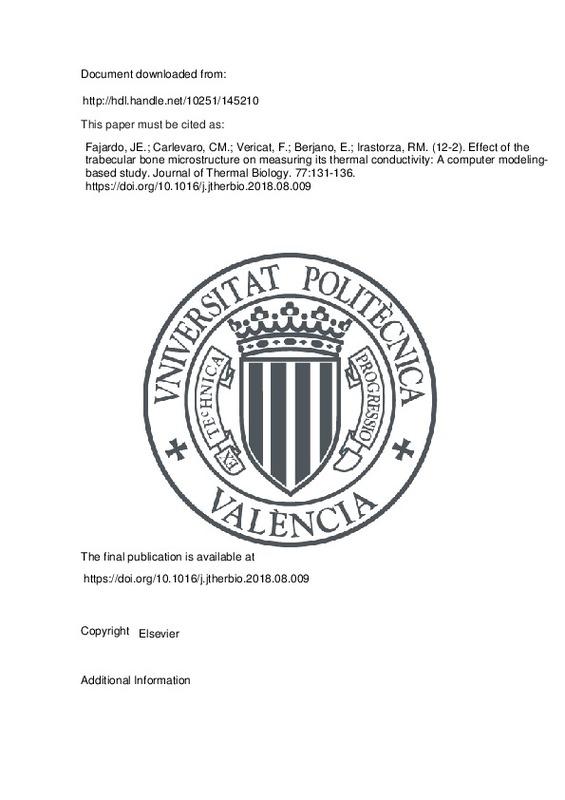JavaScript is disabled for your browser. Some features of this site may not work without it.
Buscar en RiuNet
Listar
Mi cuenta
Estadísticas
Ayuda RiuNet
Admin. UPV
Effect of the trabecular bone microstructure on measuring its thermal conductivity: A computer modeling-based study
Mostrar el registro sencillo del ítem
Ficheros en el ítem
| dc.contributor.author | Fajardo, Jesús E.
|
es_ES |
| dc.contributor.author | Carlevaro, C. Manuel
|
es_ES |
| dc.contributor.author | Vericat, Fernando
|
es_ES |
| dc.contributor.author | Berjano, Enrique
|
es_ES |
| dc.contributor.author | Irastorza, Ramiro Miguel
|
es_ES |
| dc.date.accessioned | 2020-06-04T06:31:08Z | |
| dc.date.available | 2020-06-04T06:31:08Z | |
| dc.date.issued | 2018-12 | es_ES |
| dc.identifier.issn | 0306-4565 | es_ES |
| dc.identifier.uri | http://hdl.handle.net/10251/145210 | |
| dc.description.abstract | [EN] The objective of this work is to quantify the relation between the value of the effective thermal conductivity of trabecular bone and its microstructure and marrow content. The thermal conductivity of twenty bovine trabecular bone samples was measured prior to and after defatting at 37, 47, and 57 degrees C. Computer models were built including the microstructure geometry and the gap between the tissue and measurement probe. The thermal conductivity (k) measured was 0.39 +/- 0.06 W m(-1) K-1 at 37 degrees C, with a temperature dependence of + 0.2%degrees C-1. Replacing marrow by phosphate-buffered saline (defatting) increased both the computer simulations and measurement results by 0.04 W m(-1) K-1. The computer simulations showed that k increases by 0.02-0.04 W m(-1) K-1 when the model includes a gap filled by phosphate-buffered saline between the tissue and measurement probe. In the presence of microstructure and fatty red marrow, k varies by +/- 0.01 W m(-1) K-1 compared with the case considering matrix only, which suggests that there are no significant differences between cortical and trabecular bone in terms of k. The computer results showed that the presence of a gap filled by phosphate-buffered saline around the energy applicator changes maximum temperature by < 0.7 degrees C, while including the bone microstructure involved a variation of < 0.2 mm in the isotherm location. Future experimental studies on measuring the value of k involving the insertion of a probe into the bone through a drill hole should consider the bias found in the simulations. Thermal models based on a homogeneous geometry (i.e. ignoring the microstructure) could provide sufficient accuracy. | es_ES |
| dc.description.sponsorship | This work was supported by a grant from the "Agencia Nacional de Promocion Cientfica y Tecnologica de Argentina" (Ref. PICT-2016-2303), by the National Scientific and Technical Research Council of Argentina (Grant PIO CONICET-UNAJ 0001), and by the Spanish "Programa Estatal de Investigacion, Desarrollo e Innovacion Orientada a los Retos de la Sociedad" under Grant TEC2014-52383-C3-R (TEC2014-52383-C3-1-R). | es_ES |
| dc.language | Inglés | es_ES |
| dc.publisher | Elsevier | es_ES |
| dc.relation.ispartof | Journal of Thermal Biology | es_ES |
| dc.rights | Reconocimiento - No comercial - Sin obra derivada (by-nc-nd) | es_ES |
| dc.subject | Computer model | es_ES |
| dc.subject | Thermal conductivity | es_ES |
| dc.subject | Trabecular bone | es_ES |
| dc.subject.classification | TECNOLOGIA ELECTRONICA | es_ES |
| dc.title | Effect of the trabecular bone microstructure on measuring its thermal conductivity: A computer modeling-based study | es_ES |
| dc.type | Artículo | es_ES |
| dc.identifier.doi | 10.1016/j.jtherbio.2018.08.009 | es_ES |
| dc.relation.projectID | info:eu-repo/grantAgreement/ANPCyT//PICT-2016-2303/AR/Desarrollo e implementación de una metodología para la evaluación in vivo de la calidad ósea./ | es_ES |
| dc.relation.projectID | info:eu-repo/grantAgreement/CONICET//PIO CONICET-UNAJ 0001/ | es_ES |
| dc.relation.projectID | info:eu-repo/grantAgreement/MINECO//TEC2014-52383-C3-1-R/ES/TECNOLOGIAS BASADAS EN ENERGIA DE RADIOFRECUENCIA Y MICROONDAS PARA CIRUGIA DE MINIMA INVASION/ | es_ES |
| dc.rights.accessRights | Abierto | es_ES |
| dc.contributor.affiliation | Universitat Politècnica de València. Departamento de Ingeniería Electrónica - Departament d'Enginyeria Electrònica | es_ES |
| dc.description.bibliographicCitation | Fajardo, JE.; Carlevaro, CM.; Vericat, F.; Berjano, E.; Irastorza, RM. (2018). Effect of the trabecular bone microstructure on measuring its thermal conductivity: A computer modeling-based study. Journal of Thermal Biology. 77:131-136. https://doi.org/10.1016/j.jtherbio.2018.08.009 | es_ES |
| dc.description.accrualMethod | S | es_ES |
| dc.relation.publisherversion | https://doi.org/10.1016/j.jtherbio.2018.08.009 | es_ES |
| dc.description.upvformatpinicio | 131 | es_ES |
| dc.description.upvformatpfin | 136 | es_ES |
| dc.type.version | info:eu-repo/semantics/publishedVersion | es_ES |
| dc.description.volume | 77 | es_ES |
| dc.relation.pasarela | S\367445 | es_ES |
| dc.contributor.funder | Ministerio de Economía, Industria y Competitividad | es_ES |
| dc.contributor.funder | Agencia Nacional de Promoción Científica y Tecnológica, Argentina | es_ES |
| dc.contributor.funder | Consejo Nacional de Investigaciones Científicas y Técnicas, Argentina | es_ES |







![[Cerrado]](/themes/UPV/images/candado.png)

